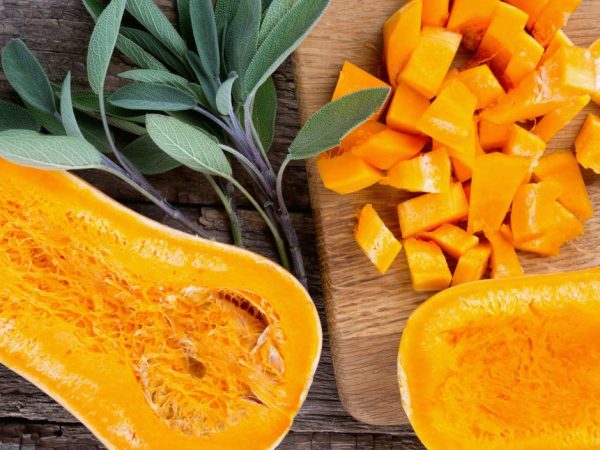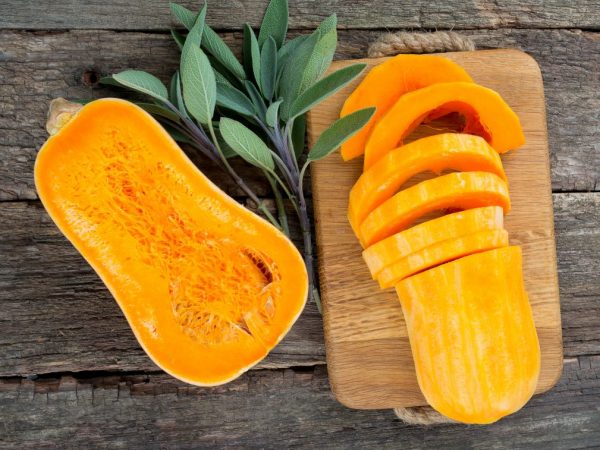Growing Butternut Pumpkin
Butternut pumpkin is in great demand in cooking. It was bred in 1960 by American breeders, and it was the first to be grown artificially. The vegetable gained its popularity due to its unusual taste, which go well with many types of meat.

Growing Butternut Pumpkin
Characteristic
Pumpkin variety Butternut was developed in America in the second half of the 20th century. To get this spicy vegetable, two types of pumpkins were crossed - the nutmeg and the wild African culture.
The main advantage of a vegetable is that it ripens quickly: literally 90 days are enough for the crop to be ready for harvest. This pumpkin tastes interesting. Its pulp is soft, juicy, sweet, with a nutmeg flavor, for which the culture received its second name - nut. In structure, it is oily and easy to store.
The nut gourd is pear-shaped. All its seeds are concentrated at the bottom, which is convenient for cooking, because they can be removed quickly and easily. The color of the peel is pale orange, and inside the pumpkin is already a more intense yellow-orange hue.
Vegetables of this kind do not grow large, the weight of one is 1-2 kg. The advantage of such fruits is that, if they are properly planted and looked after, about 20 pieces can be easily collected from one bush.
The variety was bred in warm climates, so the likelihood that Butternut will take root in cool regions is small. It is important to know the intricacies of planting and care. In Siberia, for example, such pumpkins are grown in greenhouses.
Benefit and harm
The characteristic indicates that, in addition to its unusual taste and softness, pumpkin also has beneficial properties. All this is due to the composition of the vegetable, because it contains coarse fibers that improve bowel function, cleanse it, and prevent stagnation and fermentation of food in it.
If pumpkin is eaten regularly, it will provide the intestines with a timely cleansing, i.e. a person will forget what an upset stomach is. Low-calorie variety Butternat. Girls often eat it if they are on diets.
The culture has a low glycemic index, which makes it possible to eat a vegetable for heart disease, obesity and hypertension.
It also contains many amino acids. They are beneficial for the normal functioning of the brain and heart. The composition includes several more elements that strengthen the heart muscles and teeth. There is a lot of potassium in pumpkin, and it is useful for kidney diseases, because it is able to remove excess fluid from the body, thus coping with edema.
Another important ingredient is beta-carotene. It stimulates all systems of the body to work normally. A lot of pumpkin and omega-3 are fatty acids. They are used to reduce the level of cholesterol in the blood, so the vegetable can be eaten with diseases of the gallbladder.
The composition also contains phosphorus, which forms bone tissue and strengthens it.
Pumpkin does not harm, but it has its own contraindications.It cannot be eaten by people who have an individual intolerance to the components that it contains. Due to carelessness, a person may develop an allergic reaction in the form of Quincke's edema.
It is not recommended to use Butternut pumpkin for people suffering from diabetes mellitus, or for those who have an increased level of acidity in the stomach.
Calorie content

Very useful pumpkin
As mentioned earlier, pumpkin is low in calories. It consists of 90% water, and only 45 kcal per 100 g of vegetable. For this reason, it is often used in diet menus. The remaining 10% in pumpkin is vitamins.
These include - PP, E, B1, B5, B6, but most of all vitamin C. The vegetable contains a lot of phosphorus, magnesium and calcium, which are useful for the development of muscles and bones.
Growing features
The crop is planted using seeds. Before planting, the material must be prepared. To do this, the seeds are heated at room temperature, carefully selected and soaked for a couple of hours. Then they need to be planted in pots, they do this in early May.
In advance, you need to take into account the fact that one pot is needed for one seed. There it should ripen and warm up well, only then it can be planted in the ground.
Plant a pumpkin when there is no frost. In the prepared soil, in which a shallow hole was previously made, seedlings are introduced, trying to do this so that the seeds are not close to each other. Then all the seeds are sprinkled with earth.
Growing also includes watering, because without water there will be no seedlings. You need to add moisture daily until the stems reach 15-20 cm.
Agronomists who breed different crops say that before setting the fruit, only natural ingredients should be used as fertilizer. For example, peat, humus, compost, manure. The bushes can be sprinkled with ash while they are not blooming.
If you properly care for a young plant, then after 80-90 days it will give a wonderful harvest. If the pumpkins do not ripen, then you do not need to leave them on the bush. Although the vegetable is unripe, it will acquire the desired orange hue and softness during storage.
Advantages and disadvantages
The variety has almost no minuses, the vegetable simply requires timely watering and high-quality care.
Butternut pumpkin has a lot of positive qualities. She is versatile and early maturity. The fruits ripen in just three months. The culture gives a high yield, 20 pumpkins can be harvested from one bush.
The vegetables are conveniently shaped, compact in size and light in weight. A significant advantage for cooking is that the seeds are located in groups at the bottom of the crop.
The advantage of the vegetable is also that it is stored for a long time and can ripen even outside the bush. This pumpkin is also useful, it contains a lot of vitamins, it has a pleasant and unusual taste and a bright aroma.
Diseases and pests
Like any other plant, pumpkin can be affected by various pests and diseases. Among the latter, two forms are distinguished:
- bacterial - they affect the leaves and the fruit itself, deforming it, changing the taste and composition, due to which the benefits of the product are reduced;
- fungal - they form a white bloom, due to which the plant rots and dies.
The description says: to avoid such situations, the Butternut pumpkin needs to be watered in time, it is necessary to remove weeds and loosen the ground. Before planting, it is imperative to fertilize the soil with natural fertilizing.
The most dangerous pests for a vegetable are spider mites and aphids. The remedy for them is only timely watering, as well as getting rid of the culture of diseased leaves that can infect the pumpkin. But in no case should you treat the plant with chemicals.
Cleaning rules
The pumpkin is hard in structure, so you need to pick up a stable board and a sharp knife. First, trim the bottom of the vegetable. Next, you need to remove the peel with a potato peeler. This is best done with the pumpkin upright and peeled from top to bottom.
Then the vegetable is cut in the center into two equal parts with a large sharp knife.The seeds are removed from the holes with a spoon, and the halves are divided into two more parts. This will make it easier to cut.
Now the parts are cut into straws, first across, then along, and then simply chopped into cubes. The pumpkin is ready for cooking.

